Maintenance of percolation, drip and vacuum coffee machines
Electric Coffee pot
The electric coffee pot is a kind of cooking utensils which uses electric heating to boil water automatically to make coffee. Because coffee is both boiled and brewed, it is only suitable for brewing, otherwise the coffee oil will volatilize in the boiling process and the beverage will lose its aroma and color. The electric coffee maker can meet this special production requirement.
According to its structure, the electric coffee pot can be divided into three types: percolation type, drip type and vacuum type.
1. The structure of the percolation electric coffee pot (see figure).
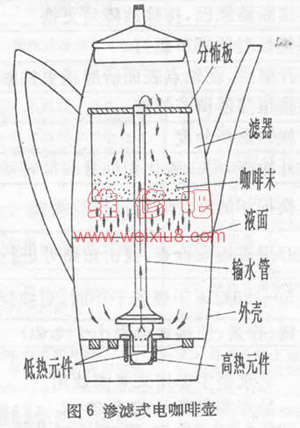
The utility model is mainly composed of a shell, a base, an electric heating element, a water pipe and a coffee filter. The electric heating element is divided into two groups: high heat group and low heat group, which is installed in the base of the pot; the pipe seat of the water pipe is fixed in the pit at the bottom of the pot, and its upper end extends and penetrates the center of the filter and distribution plate. The aqueduct and filter can be removed from the kettle.
When the power is turned on, the water in the pit is quickly heated to boiling, and the boiling water rushes out of the pipe mouth through the aqueduct and is blocked by the distribution plate on the filter when it falls, so that the water injection is dispersed and becomes smooth and uniform, and flows into the coffee particles in the filter. and then return to the pot. Cycle back and forth until the coffee is infiltrated and brewed.
The percolation type electric coffee pot can be divided into single-heat type and double-heat automatic type according to the number and control mode of electric heating elements. Dual thermal automatic circuits are usually available in three forms (see figure 7). Figure 7 (a) is a series circuit. After the power is connected, the low heat element and the indicator are short-circuited by the thermostat, and the current can only flow through the high heat element and the thermostat. When the water in the kettle is percolated to 85 ℃, the thermostat contact disconnects itself, so that the current also flows through the low heat element and the indicator. At this time, the light lit up, indicating that the coffee was ready.
After the thermostat is disconnected, the high heat element and the low heat element are connected in series. Because the resistance of the low heat element is much larger than that of the high heat element, the current is very small. These two resistor elements keep the temperature of the coffee in the pot at about 70 ℃. At this temperature, the coffee will not infiltrate again and is the most suitable for drinking.
Figure 7 (b) is another series circuit with the same principle as above, except that when the coffee is made, the indicator is off.
Figure 7 (c) is a parallel circuit. When the thermostat contacts are separated, only the low heat element works to keep the coffee warm.
Common failures and troubleshooting methods are shown in Table 2.
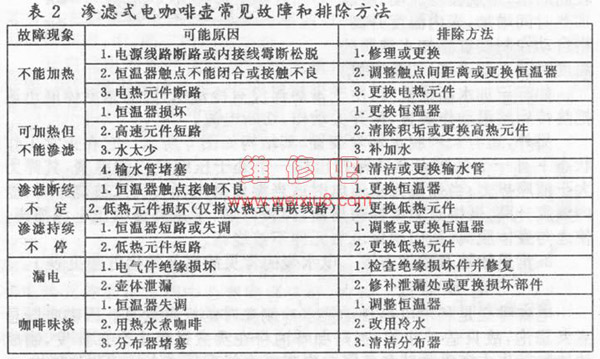
two。 Drip type electric coffee maker
The difference between the drip type and the percolation type is that the drip type is a disposable beverage, unlike the coffee liquid in the percolation type that goes through reciprocating circulation, which can better ensure the quality of the coffee beverage.
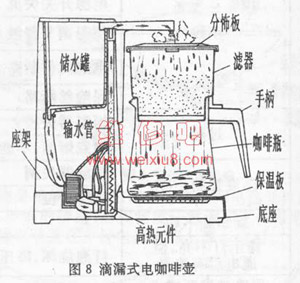
The structure of the drip type electric coffee maker is shown in figure 8. It mainly consists of three parts: a seat frame, a filter and a coffee bottle. Among them, the frame seat includes water storage tank, water pipe, electric heating element, thermostat, indicator light and other components. The filter is a funnel-shaped or water cup-shaped container with a distribution board at the upper opening and a glass or plastic filter plate (some filter paper) at the lower opening. Coffee bottles are mostly transparent glass containers with Bakelite handles, and the mouth of the bottle can be closely matched with the opening under the filter.
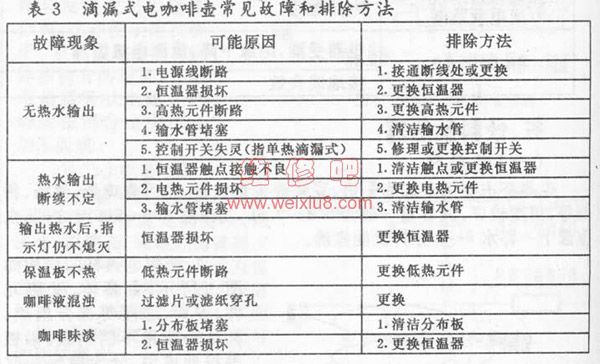
Most of the drip-type electric coffee maker has two electric heating elements of high and low temperature, as well as the same elements as the double-heat automatic filtration coffee maker. After the power is turned on, the high heat element quickly heats a small part of the water flowing from the storage tank to boiling, and the steam pressure pushes the water out of the water pipe in turn, drips evenly into the filter containing coffee powder through the distribution plate, and then flows into the coffee bottle to become drinking coffee. The insulation board at the bottom of the coffee bottle keeps the coffee at a temperature of about 75 ℃.
3. Vacuum electric coffee maker
The coffee made in vacuum electric coffee pot tastes stronger than that made in other coffee pots, so it is suitable for people who like to drink espresso.
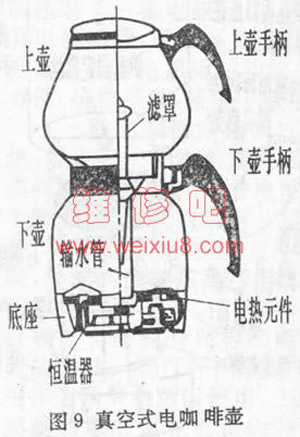
The structure of the vacuum electric coffee maker is shown in figure 9. It is mainly composed of three parts: the upper pot, the lower pot and the base. The upper and lower pots are mostly made of glass, and there is a silicone rubber sealing ring between them. A water pipe runs through the center of the two pots, and the electric heating elements and control mechanisms are installed in the base.
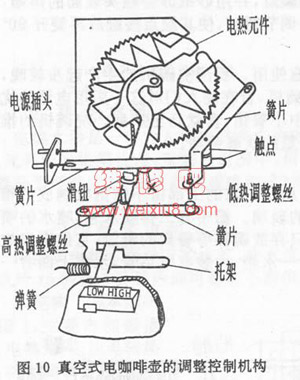
The vacuum electric coffee maker works by making use of the pressure difference between the upper and lower pots. After the power is connected, the electric heating element boils the water of the lower pot, the steam presses the water along the water pipe to the upper pot, and after the water soaked in the pot is completely lifted, the thermostat cuts off the power by itself. As the temperature drops, the pressure of the lower pot is much lower than that of the upper pot, so the upper pot presses the brewed coffee liquid back into the lower pot to form coffee suitable for drinking.
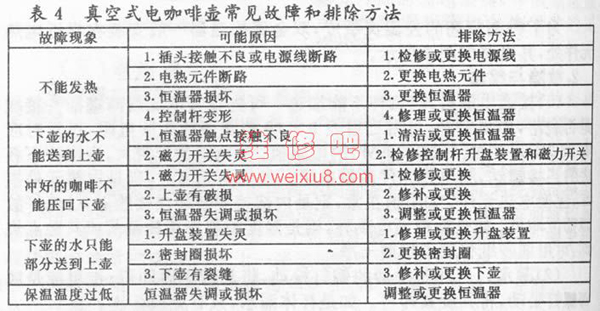
4. Adjustment of thermostat of electric coffee pot
The thermostat of most electric coffee pots is adjustable and should be adjusted when used improperly and for a long time, or when a new thermostat is installed.
Adjustment of percolation and drip coffee pots:
Most of these two kinds of electric coffee pots have an adjustment hole on the base. If you encounter a coffee pot without an adjustment hole, it is necessary to disassemble the base cover plate to adjust. If the original temperature is too low, you can use a screwdriver to turn a screw facing the adjustment hole clockwise. If the temperature is too high, turn counterclockwise. After adjustment, a liquid temperature test should be made. The standard is that the temperature rises to 85 ℃, then decreases and stabilizes in the range of 65 ℃.
Adjustment of vacuum electric coffee maker:
The control mechanism of the vacuum single thermoelectric coffee maker is shown in figure 10. The action principle is as follows: when making coffee, the switch is set in the high heat (HIGH) position to make the control rod enter the next stage of the switch bracket, while the sliding knob moves under the "×" protruding part in the picture, pushing the Reed and the low heat adjusting screw away from the bimetal sheet. After the power is turned on, the current flows through the current elements, reeds and contacts to heat the water. When all the water in the lower pot is lifted, the bimetal sheet bends upward under the influence of the temperature rise, resulting in the high heat adjusting screw and the control rod being pulled away from the position of the lower stage of the switch bracket and pulled from the spring to the low heat (LOW). At this point, the low heat adjusting screw is pushed by the bimetal sheet, which separates the two contacts and interrupts the circuit. The pressure difference causes the coffee from the upper pot to be drawn back from the next pot. When the coffee temperature drops below 75 ℃, the bimetal sheet gradually straightens, the two contacts close under the elastic action of the low heat contact spring, and the electric heating element reheats to keep the coffee coffee at a certain temperature without rising back to the upper pot.
The adjustment of the control mechanism should be carried out in a state of complete cooling. In order to prevent the electric heating element from overheating during the adjustment, a 5W bulb should be connected in series on the power cord. The adjustment method is as follows: turn on the power supply and first turn the low heat adjustment screw clockwise with a rubber handle screwdriver until the light bulb goes out. Then cut off the power, turn the screw counterclockwise and fix it. Finally, install the parts, fill the lower pot with hot water of about 65 ℃ with a capacity of 1 stroke 2, and then turn on the power supply. After reaching the steady state (about 20 minutes), the water temperature measured in the lower pot should be about 75 ℃. If the water temperature is lower than 70 ℃, the low heat adjusting screw should be turned clockwise. If the water temperature is higher than 80 ℃, it should be adjusted in the opposite direction, and the temperature can be changed by 15 ℃ per rotation.
China Coffee Trading Network: www.gafei.com
Important Notice :
前街咖啡 FrontStreet Coffee has moved to new addredd:
FrontStreet Coffee Address: 315,Donghua East Road,GuangZhou
Tel:020 38364473
- Prev
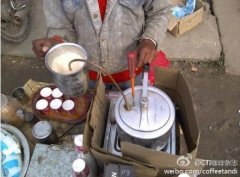
Incredible Indian homemade milking pressure cooker
Incredible Indian homemade milking pressure cooker Made in India,Garbage + Engineering = Cappuccinoplastics!
- Next
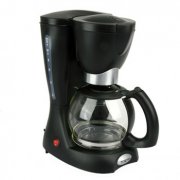
Tips for the use of household percolation electric coffee maker
Although the coffee pot is easy to use, it is also fastidious in use and maintenance. You might as well take a look at it together.
Related
- What is the Philharmonic pressure? How to use Philharmonic pressure to make delicious coffee
- Why does a hand grinder have more fine powder than an electric grinder?
- In addition to the hot mom, what is the difference between the versions of EK43 | ditting and Mahdi ek43?
- What kind of equipment do you need to make coffee by hand? Introduction to novice starter cooking equipment tools
- Espresso needs to be ground how thick and thin scale entry Italian Coffee Machine Bean Grinder investigation and Grinding course
- How much does it cost to open a small private cafe? How much does it cost to learn coffee? How to operate it?
- The difference between the flavor characteristics of hand-brewed coffee and coffee maker is hand-brewed coffee really better than coffee maker? Can I use a coffee machine to make coffee beans by hand?
- The difference between 01 and 02 of hario v60 filter cup what is the difference between 01 and 02 filter cup opening and cooking flavor
- What's the difference between the smart cup and the French kettle? Which is better, the French kettle or the Smart Cup?
- What's the difference between a smart cup and a V60 filter cup? The difference between the taste of smart cup and hand-brewed coffee

